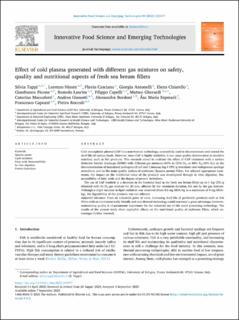| dc.contributor.author | Tappi, Silvia | |
| dc.contributor.author | Nissen, Lorenzo | |
| dc.contributor.author | Casciano, Flavia | |
| dc.contributor.author | Antonelli, Giorgia | |
| dc.contributor.author | Chiarello, Elena | |
| dc.contributor.author | Picone, Gianfranco | |
| dc.contributor.author | Laurita, Romolo | |
| dc.contributor.author | Capelli, Filippo | |
| dc.contributor.author | Gherardi, Matteo | |
| dc.contributor.author | Maccaferri, Caterina | |
| dc.contributor.author | Gianotti, Andrea | |
| dc.contributor.author | Bordoni, Alessandra | |
| dc.contributor.author | Espmark, Åsa Maria Olofsdotter | |
| dc.contributor.author | Capozzi, Francesco | |
| dc.contributor.author | Rocculi, Pietro | |
| dc.date.accessioned | 2023-09-14T07:12:40Z | |
| dc.date.available | 2023-09-14T07:12:40Z | |
| dc.date.created | 2023-09-13T08:53:08Z | |
| dc.date.issued | 2023 | |
| dc.identifier.citation | Innovative Food Science & Emerging Technologies. 2023, 89 1-9. | en_US |
| dc.identifier.issn | 1466-8564 | |
| dc.identifier.uri | https://hdl.handle.net/11250/3089324 | |
| dc.description.abstract | Cold atmospheric plasma (CAP) is a non-thermal technology, successfully used to decontaminate and extend the shelf-life of various foods. However, since CAP is highly oxidative, it can cause quality deterioration in sensitive matrices, such as fish products. This research aimed to evaluate the effect of CAP treatment with a surface dielectric barrier discharge (SDBD) with different gas mixtures (80% Ar/20% O2, or 80% N2/20% O2) on the decontamination of inoculated pathogens (E.coli and L.innocua; log 4 CFU/g inoculum) and endogenous spoilage microbiota and on the main quality indices of seabream (Spaurus aurata) fillets. For selected appropriate treatments, the impact on the nutritional value of the products was investigated through in vitro digestion, bioaccessibility of fatty acids and the degree of protein hydrolysis. The use of CAP resulted in a decrease in the bacterial load in the fresh sea bream fillets up to 1 log CFU/g obtained with Ar/O2 gas mixture for 20 min, affected by the treatment duration, but not by the gas mixture. Although a slight increase in lipid oxidation was observed (from 0.5 mg MDA/kg to a maximum of 4 mg MDA/kg), the digestibility of the products was not affected. Industrial relevance From an industrial point of view, increasing shelf-life of perishable products such as fish fillets with an environmentally friendly and non-thermal technology could represent a great advantage; however, maintaining quality is of paramount importance for the industrial use of this novel processing technology. The results of the present study show negligible effects on the nutritional quality of seabream fillets, which encourages further research. | en_US |
| dc.language.iso | eng | en_US |
| dc.title | Effect of cold plasma generated with different gas mixtures on safety, quality and nutritional aspects of fresh sea bream fillets | en_US |
| dc.title.alternative | Effect of cold plasma generated with different gas mixtures on safety, quality and nutritional aspects of fresh sea bream fillets | en_US |
| dc.type | Journal article | en_US |
| dc.type | Peer reviewed | en_US |
| dc.description.version | publishedVersion | en_US |
| dc.source.pagenumber | 1-9 | en_US |
| dc.source.volume | 89 | en_US |
| dc.source.journal | Innovative Food Science & Emerging Technologies | en_US |
| dc.identifier.doi | https://doi.org/10.1016/j.ifset.2023.103477 | |
| dc.identifier.cristin | 2174527 | |
| cristin.ispublished | true | |
| cristin.fulltext | original | |
| cristin.qualitycode | 1 | |
